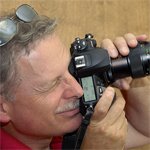Regarded by some as an amateur contrivance, Auto ISO is truly one of the most powerful tools available on your DSLR. Combined with our knowledge of handling noise successfully, having automated ISO as part of your shooting strategy is a mark of maturity among knowledgeable shooters. How so?
Situation You're covering an outdoor event on a sunny day (or a high contrast stage lighting environment) where lighting is different everywhere you turn. The dynamic range of the scenes is often far beyond our sensors ability to record easily. We need need intuitive camera control!
Problem We've got our favorite mode in place - A, S , P or even Manual. Spot metering is isolating our subject for accurate exposures. AF is in Continuous Mode with Tracking Lock-on activated. iTTL flash is at the ready to add fill and, eventually, become our main light source. Seems like we're in control, but as the lighting changes and the day draws on bringing afternoon shadows... keeping an accurate exposure is a dizzying accomplishment. Then, as light fades, the flash ceases to expose adequately, so we raise the ISO manually. Later, we resort to exposure compensation dialing. Then flash compensation dialing. Shutter speeds slow and apertures widen - creating mental fatigue which is robbing us of enthusiasm and creativity. What to do?
Solution Enter Auto ISO - champion of automated camera control! With one swift switch, we have continuously automated adjustment of all the aforementioned areas. Set to run from a 1/8th shutter speed and up to the top ISO available, our camera will now follow our lead obediently. Watch it work...
Set up in Program, A, or S mode, as light increases Auto ISO lowers sensor speeds, shutter speeds increase and flash output fills automatically. As light dims, Program mode will to respect our need to use handheld settings, while A and S modes adjust their respective variables to suit the situation. In the background, ISO moves up or down to maintain these desired camera operations.
In A or S mode, we can hold onto our desired f-stop or shutter speed as ISO moves around for us - but this is a bit less flexible in realtime use as you push ISO's up more quickly at f8 or a 1/250th shutter speed. Good lenses shoot well more side open and VR optics give us easy handheld capability in the 1/25th range - this will really extend Auto ISO's contribution.
Ingeniously, as light diminishes, Auto ISO coordinates usable settings with Nikon's superb iTTL flash adding more output to illuminate the scene as needed - going from fill to main when the need arises. Recycle times will be affected more by our default f-stop or shutter speed, so haggle out a workable combination of shooting at f4.5 or 1/25th and Auto ISO will take up the slack nicely.
For the most part the camera is now self-running - very cool. The other side of Auto ISO is proficient postprocessing. Top end DSLR's (D2x, D200, D300, D3) will handle noise fairly almost to their ISO limits. Midrange DSLR shooters (D40, D40x, D50, D70, D60, D80) will need to avoids excessively high ISO's to keep images from breaking up on the computer - set your ISO limit to around 1600 to be safe.
With Auto ISO, we can extend the range of useful operation in any situation until we either run out of recordable ambient light or available flash power. I prefer to use S mode to maintain handheld shutter speeds during a wedding or even casual snapshooting. you can create your own strategy based on shooting preferences you practiced over the years. Any way you do it, Auto ISO givs you greater control of fast moving, action-packed shooting... use it!
Tuesday, July 15, 2008
Subscribe to:
Post Comments (Atom)



No comments:
Post a Comment